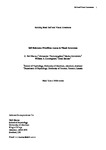Self-relevance prioritizes access to visual awareness.
| dc.contributor.author | Macrae, CN | en |
| dc.contributor.author | Visokomogilski, A | en |
| dc.contributor.author | Golubickis, M | en |
| dc.contributor.author | Cunningham, WA | en |
| dc.contributor.author | Sahraie, A | en |
| dc.date.accessioned | 2020-04-07T11:31:49Z | |
| dc.date.available | 2020-04-07T11:31:49Z | |
| dc.date.issued | 2017-03 | en |
| dc.identifier.uri | http://hdl.handle.net/10026.1/15532 | |
| dc.description.abstract |
As we are cognizant of only a fraction of the available visual inputs at any given time, how is information selected for access to consciousness? In particular, does the personal significance of stimuli influence perceptual selection? Given that self-relevant information is prioritized during various stages of processing, here we hypothesized that self-association may privilege access to awareness under continuous flash suppression (CFS). The results supported this prediction. Compared with geometric shapes referenced to either a friend or stranger, those previously associated with self were prioritized in visual awareness. To establish the basis of this effect, the processes underlying task performance were investigated using a hierarchical drift diffusion model approach. These analyses showed that self-prioritization mapped onto both the decisional (i.e., starting value, z) and nondecisional (i.e., t₀) parameters of the diffusion model. The implications of these findings are considered. (PsycINFO Database Record | en |
| dc.format.extent | 438 - 443 | en |
| dc.language | eng | en |
| dc.language.iso | eng | en |
| dc.subject | Adult | en |
| dc.subject | Awareness | en |
| dc.subject | Ego | en |
| dc.subject | Female | en |
| dc.subject | Humans | en |
| dc.subject | Male | en |
| dc.subject | Memory, Short-Term | en |
| dc.subject | Pattern Recognition, Visual | en |
| dc.subject | Psychomotor Performance | en |
| dc.subject | Young Adult | en |
| dc.title | Self-relevance prioritizes access to visual awareness. | en |
| dc.type | Journal Article | |
| plymouth.author-url | https://www.ncbi.nlm.nih.gov/pubmed/28240929 | en |
| plymouth.issue | 3 | en |
| plymouth.volume | 43 | en |
| plymouth.publication-status | Published | en |
| plymouth.journal | J Exp Psychol Hum Percept Perform | en |
| dc.identifier.doi | 10.1037/xhp0000361 | en |
| plymouth.organisational-group | /Plymouth | |
| plymouth.organisational-group | /Plymouth/Faculty of Health | |
| plymouth.organisational-group | /Plymouth/Faculty of Health/School of Psychology | |
| plymouth.organisational-group | /Plymouth/REF 2021 Researchers by UoA | |
| plymouth.organisational-group | /Plymouth/REF 2021 Researchers by UoA/UoA04 Psychology, Psychiatry and Neuroscience | |
| plymouth.organisational-group | /Plymouth/REF 2021 Researchers by UoA/UoA04 Psychology, Psychiatry and Neuroscience/UoA04 Psychology, Psychiatry and Neuroscience MANUAL | |
| plymouth.organisational-group | /Plymouth/Users by role | |
| plymouth.organisational-group | /Plymouth/Users by role/Academics | |
| dc.publisher.place | United States | en |
| dc.identifier.eissn | 1939-1277 | en |
| dc.rights.embargoperiod | Not known | en |
| rioxxterms.versionofrecord | 10.1037/xhp0000361 | en |
| rioxxterms.licenseref.uri | http://www.rioxx.net/licenses/all-rights-reserved | en |
| rioxxterms.type | Journal Article/Review | en |


